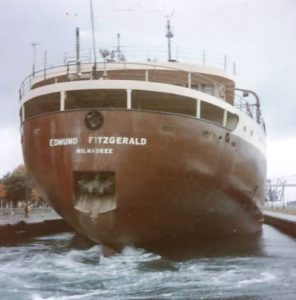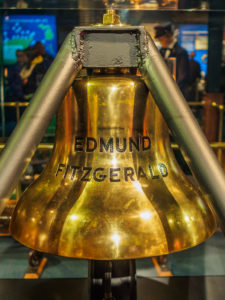
The Edmund Fitzgerald. Image credit: U.S. Army Corps of Engineers
The 45th anniversary of the loss of the iron ore freighter the Edmund Fitzgerald is Nov. 10. The Gordon Lightfoot song about this tragedy is admittedly an earworm but it is also accurate with its facts. The 729-foot ship faced a fierce storm with 50-knot winds and towering waves when “the gales of November came slashing.”
Because the ship left on its last voyage from Superior, Wisconsin, it can sometimes be thought the vessel went down in the waters of the Badger State, or the U.S. at least. Wisconsin Historical Society Maritime Archaeologist Tamara Thomsen, a longtime Sea Grant partner, said the fate of the Edmund Fitzgerald and where it went down are common questions during the literally hundreds of shipwreck presentations she has delivered through the years
In fact, at a depth of 530 feet, the ship lies split in two near Whitefish Point, Michigan, but is in the Canadian waters of Lake Superior. The lake is the final resting place for 29 men.
The compelling tales of 760 other lakes Michigan and Superior shipwrecks can be found at wisconsinshipwrecks.org, a project of Sea Grant and the Wisconsin Historical Society. Information on the ships’ construction, service histories, final voyages and locations are searchable, as are any relevant videos and photos.

Image credit: Jeff Hormann, Creative Commons
Other shipwrecks that may be in the area are described. Nearby attractions such as historic waterfronts, lighthouses, museums, historic vessels, charter services, theaters, waterfront parks or archeological sites are also linked with each ship’s story. These attractions are searchable by location and category, as well.
The “learn” section of the site provides visitors with information about underwater archeology, the value of studying shipwrecks and how the studies are undertaken, field reports, a calendar of shipwreck-related events, a glossary of ship terms and a list of archival newspaper stories about the waters and their wrecks.
Finally, the site explains the location and details of maritime trail historical markers so landlubbers can explore maritime history in a socially distanced way.
As we commemorate this year’s date of the sinking of the Edmund Fitzgerald, and just as in all other shipwrecks that led to loss of life, “All that remains is the faces and the names of the wives and the sons and the daughters.”


